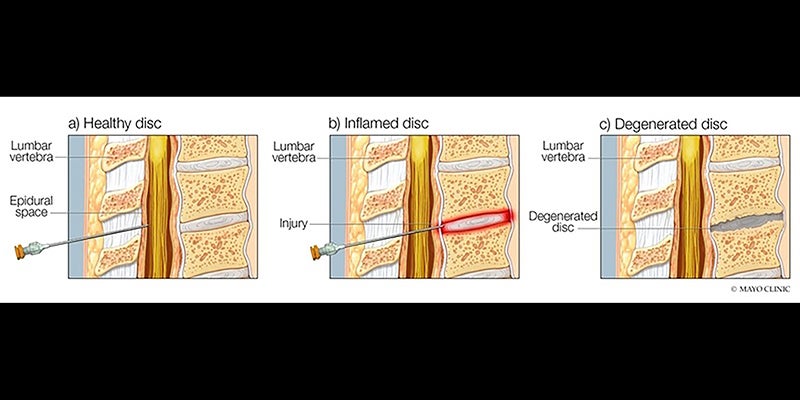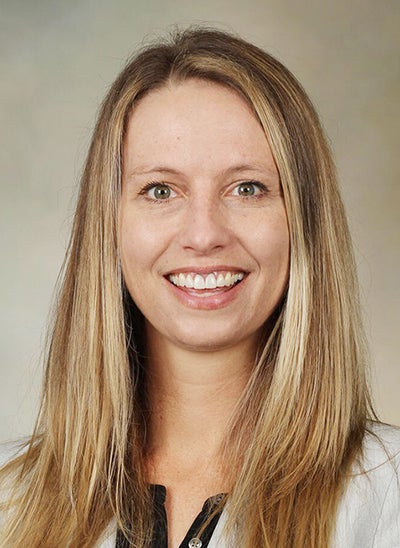Pain relief for worn spinal disks
Published 6:12 pm Tuesday, November 29, 2022

- Healthy disc, inflamed disc and degenerated disc. Graphic provided
|
Getting your Trinity Audio player ready...
|
LA CROSSE, Wis. — There are 23 disks in the spinal column, running from the base of the skull to the tailbone. There are six cervical, 12 thoracic and five in the lumbar region. They allow the spine to be flexible without sacrificing a great deal of strength. Most importantly, disks are fluid-filled cushions between the bones in your spine.
“Like air bags in a car, disks prevent the vertebrae from hitting each other and are shock absorbers,” says Kendall Snyder, M.D., a neurosurgeon at Mayo Clinic Health System. “For most young people, disks are healthy. The disk is flexible with fluid, and it fills the space between the vertebrae and provides necessary cushion to allow their spines to bend and flex fully without pain.”

Kendall Snyder, M.D.
Unfortunately, disks wear out with age and use. About 20% of all U.S. adults have some amount of degeneration by age 65. This increases to about 35% by age 80. This is called degenerative disk disease, which is usually a slow degradation of disks over time.
“Degenerative disk disease is a result of multiple factors, some that can be controlled and others that can’t,” Snyder explains. “Age and time increase the odds of developing degenerative disk disease. Gender plays a factor, as females are more likely than males to develop degenerative disk disease.”
Factors that can be controlled include excess body weight and spine strain due to manual labor, poor posture, or heavy lifting. However, everyone has a degree of degeneration with time. It may or may not worsen or cause symptoms.
“Progression can be stagnant, slow or fast. As degenerative disk disease begins, the spinal disks start to lose fluidity. They become dehydrated, and are not as rubbery or soft. This leads to disks shrinking and a loss of disk height. Often, the disks that are low in the spine degenerate first,” says Snyder.
As degeneration progresses further, Snyder says the disks dry out even more and may begin pushing on nerves. A person could develop a ruptured or bulging disk. Often people have a bulging or ruptured disk with no symptoms, but sometimes this can cause symptoms in one or both legs.
Snyder says a bulging disk happens when the outer layer of the disk, the annulus fibrosis, bulges into the spinal canal. A ruptured disk, sometimes called a herniated or slipped disk, happens when the inner part of the disk, the nucleus pulposus, leaks out of the disk through a crack in the annulus fibrosis.
“If the disks continue to degrade, it can result in a complete loss of the disk,” explains Snyder. “Then, the person only has an air-filled space between the vertebrae, or the bones of two vertebral bodies directly contact each other. A person with this level of progression can experience severe pain, stiffness and possibly nerve compression.”
There are many treatment options for degenerative disk disease.
Snyder suggests the first treatment option usually focuses on nonsurgical treatments. Weight loss can be extremely beneficial, along with decreasing the manual labor on the spine. Injections, medications, physical therapy and strengthening your core can ease symptoms.
“Surgery is only an option after nonsurgical treatments are exhausted first,” Snyder offers. “It is considered if the condition is causing symptoms of nerve compression and these symptoms are progressing despite physical therapy, medications and injections. Symptoms from nerve compression may include pain, numbness or weakness that radiates into a limb. Surgery is usually not a good option for treating solely back pain from osteoarthritis in the spine.”
Snyder say surgical options for degenerative disk disease include:
• Decompression surgery, such as a laminectomy or diskectomy, creates space for the compressed nerves by removing part of the vertebrae bone or damaged part of the disk. Relieving pressure on the spinal cord or nerves can ease symptoms.
• Stabilization surgery, such as a spinal fusion, improves stability by permanently connecting two or more vertebrae in the spine. It may be performed after a decompression surgery for certain surgical indications of the spine.
• Disk replacement surgery replaces a worn-out disk with an artificial disk. Replacing a disk may help relieve pain in your arms or legs while maintaining motion and flexibility.
“Your health care team, including experts in pain management, physical medicine and rehabilitation, physical therapy, and neurosurgery, will work together to tailor a treatment plan for you,” says Snyder




